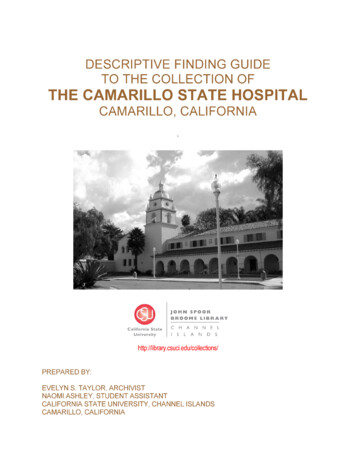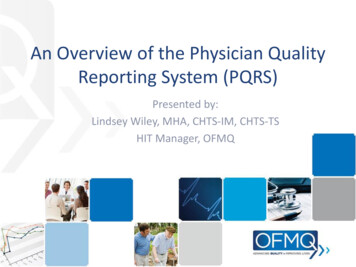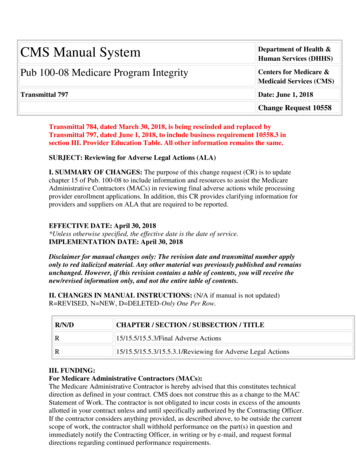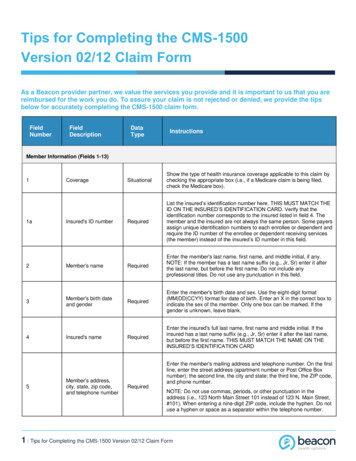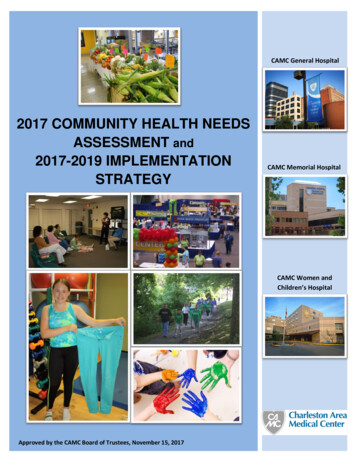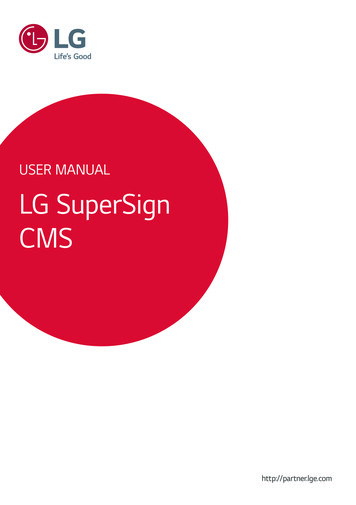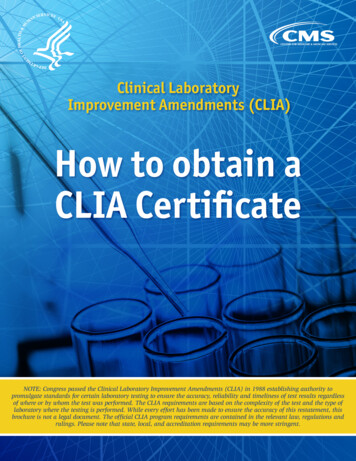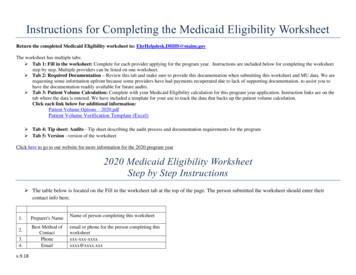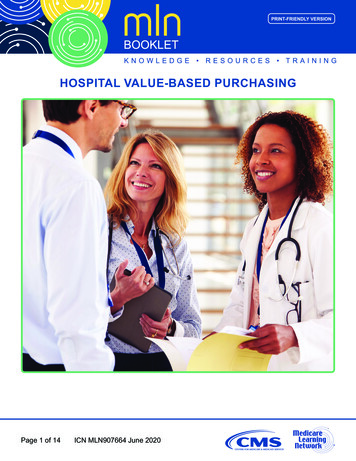
Transcription
PRINT-FRIENDLY VERSIONHOSPITAL VALUE-BASED PURCHASINGPage 1 of 14ICN MLN907664 June 2020
Hospital Value-Based PurchasingMLN BookletTABLE OF CONTENTSUpdates . 3Introduction. 4How Does Hospital VBP Work? . 4How Does the VBP Program Measure Hospital Performance?. 4How Is Hospital Performance Scored? . 7What Are the Hospital VBP Program Performance Periods? .11When Are the Hospital VBP Payment Adjustments Made? . 13How Is the Hospital VBP Program Funded? . 13Key Takeaways . 13Resources . 14Page 2 of 14ICN MLN907664 June 2020
Hospital Value-Based PurchasingMLN BookletUPDATESNote: We revised this product with the following content updates: Added information on relief for clinicians, providers, hospitals, and facilities participatingin quality reporting and value-based purchasing programs due to the COVID-19 publichealth emergency Added Hospital VBP domains and relative weights for FYs 2018–2023 Revised Hospital VBP measures for FYs 2021–2023 Revised baseline and performance periods for FYs 2021–2023Page 3 of 14ICN MLN907664 June 2020
Hospital Value-Based PurchasingMLN BookletINTRODUCTIONThe CMS Hospital Value-Based Purchasing (VBP) Program rewards acute-care hospitals with incentivepayments for quality care to Medicare patients.SSA Section 1886(o) established the Hospital VBP Program, affecting payment for inpatient stays inabout 3,000 hospitals across the country. This program is part of CMS’ new Meaningful Measuresinitiative to improve outcomes for patients, their families, and providers while reducing burden onclinicians and providers.This booklet explains how the Hospital VBP Program works and how we measure and score hospitalperformance. It also lays out changes to future Hospital VBP Program years.HOW DOES HOSPITAL VBP WORK?Medicare pays hospitals for inpatient acute care services based on the quality of care (evaluated usinga select set of quality and cost measures), not just the quantity of the services they provide. Under theHospital VBP Program, Medicare makes incentive payments to hospitals based on either: How well they perform on each measure compared to other hospitals’ performance during abaseline period How much they improve their performance on each measure compared to their performanceduring a baseline periodReport performance information through the QualityNet Hospital Quality Reporting (HQR) Portal.The HQR is the secure extranet portal supporting Center for Clinical Standards and Quality (CCSQ)reporting programs for health care providers and their supporting vendors.HOW DOES THE VBP PROGRAMMEASURE HOSPITAL PERFORMANCE?CMS bases hospital performance on an approved set of measures and dimensions grouped intospecific quality domains. CMS assigns domain weights (percentages) which are then used to scoreeach domain.Table 1. Hospital VBP Domains & Relative WeightsDomainSafetyClinical OutcomesEfficiency and Cost ReductionPerson and Community EngagementPage 4 of 14ICN MLN907664 June 2020Weight25%25%25%25%
Hospital Value-Based PurchasingMLN BookletTable 2. FY 2021 Hospital VBP Program MeasuresMeasure IDMeasure d Urinary Tract InfectionCentral Line-Associated Blood Stream InfectionClostridium difficile Infection (C. difficile)Methicillin-Resistant Staphylococcus aureus BacteremiaSurgical Site Infection:DomainSafetySafetySafetySafetySafety MP-HIP-KNEEMSPBHospital ConsumerAssessmentof HealthcareProvidersand Systems(HCAHPS) Survey Abdominal HysterectomyAcute Myocardial Infarction (AMI) 30-Day Mortality RateChronic Obstructive Pulmonary Disease (COPD) 30-DayMortality RateHeart Failure (HF) 30-Day Mortality RatePneumonia (PN) 30-Day Mortality RateTotal Hip Arthroplasty (THA) and/or Total KneeArthroplasty (TKA) Complication RateMedicare Spending per Beneficiary (MSPB) Communication with Nurses Communication with Doctors Responsiveness of Hospital Staff Communication about Medicines Hospital Cleanliness and Quietness Discharge Information Care Transition Overall Rating of HospitalPage 5 of 14ICN MLN907664 June 2020Clinical OutcomesClinical OutcomesClinical OutcomesClinical OutcomesClinical OutcomesEfficiency and CostReductionPerson andCommunityEngagement
Hospital Value-Based PurchasingMLN BookletTable 3. FY 2022 Hospital VBP Program MeasuresMeasure IDMeasure d Urinary Tract InfectionCentral Line-Associated Blood Stream InfectionClostridium difficile Infection (C. difficile)Methicillin-Resistant Staphylococcus aureus BacteremiaSurgical Site Infection:DomainSafetySafetySafetySafetySafety ColonMSPB Abdominal HysterectomyAcute Myocardial Infarction (AMI) 30-Day Mortality RateCoronary Artery Bypass Grafting (CABG) 30-DayMortality RateChronic Obstructive Pulmonary Disease (COPD) 30-DayMortality RateHeart Failure (HF) 30-Day Mortality RatePneumonia (PN) 30-Day Mortality RateTotal Hip Arthroplasty (THA) and/or Total KneeArthroplasty (TKA) Complication RateMedicare Spending per Beneficiary (MSPB)HCAHPS Survey Communication with FMORT-30-PNCOMP-HIP-KNEE Communication with Doctors Responsiveness of Hospital Staff Communication about Medicines Hospital Cleanliness and Quietness Discharge Information Care Transition Overall Rating of HospitalPage 6 of 14ICN MLN907664 June 2020Clinical OutcomesClinical OutcomesClinical OutcomesClinical OutcomesClinical OutcomesClinical OutcomesEfficiency and CostReductionPerson andCommunityEngagement
Hospital Value-Based PurchasingMLN BookletTable 4. FY 2023 Hospital VBP Program MeasuresMeasure IDMeasure d Urinary Tract InfectionCentral Line-Associated Blood Stream InfectionClostridium difficile Infection (C. difficile)Methicillin-Resistant Staphylococcus aureus BacteremiaSurgical Site Infection:DomainSafetySafetySafetySafetySafety ColonMSPB Abdominal HysterectomyPatient Safety and Adverse Events CompositeAcute Myocardial Infarction (AMI) 30-Day Mortality RateCoronary Artery Bypass Grafting (CABG) 30-DayMortality RateChronic Obstructive Pulmonary Disease (COPD)30-Day Mortality RateHeart Failure (HF) 30-Day Mortality RatePneumonia (PN) 30-Day Mortality RateTotal Hip Arthroplasty (THA) and/or Total KneeArthroplasty (TKA) Complication RateMedicare Spending per Beneficiary (MSPB)HCAHPS Survey Communication with NursesCMS PSI T-30-PNCOMP-HIP-KNEE Communication with Doctors Responsiveness of Hospital StaffSafetyClinical OutcomesClinical OutcomesClinical OutcomesClinical OutcomesClinical OutcomesClinical OutcomesEfficiency and CostReductionPerson andCommunityEngagement Communication about Medicines Hospital Cleanliness and Quietness Discharge Information Care Transition Overall Rating of HospitalHOW IS HOSPITAL PERFORMANCE SCORED?CMS assesses each hospital’s total performance by comparing its Achievement and Improvementscores for each applicable Hospital VBP measure. CMS uses a threshold and benchmark todetermine how many points to award for the Achievement and Improvement scores. CMS comparesthe Achievement and Improvement scores and uses whichever is greater.Page 7 of 14ICN MLN907664 June 2020
Hospital Value-Based PurchasingMLN Booklet Benchmark: Average (mean) performance of the top 10% of hospitals during the baseline periodFigure 1: ark Achievement Threshold: Performance at the 50th percentile (median) of hospitals during thebaseline periodFigure 2: Achievement ThresholdLowScoreHighScore50th PercentileTo determine the domain scores, CMS adds points across all measures.Page 8 of 14ICN MLN907664 June 2020
Hospital Value-Based PurchasingMLN Booklet Achievement points are awarded by comparing an individual hospital’s rates during theperformance period to all hospitals’ rates from the baseline period: Hospital rates at or better than the benchmark 10 Achievement points Hospital rates worse than the Achievement threshold 0 Achievement points Hospital’s rate is equal to or better than the Achievement threshold but worse than thebenchmark 1–9 Achievement pointsFigure 3: Achievement PointsAll HospitalsYour HospitalTime Improvement points are awarded by comparing an individual hospital’s rates during theperformance period to its rates from the baseline period: Hospital rates at or better than the benchmark 9 Improvement points Hospital rates at or worse than baseline period rate 0 Improvement points Hospital’s rate is better than its baseline period score but worse than the benchmark 0–9Improvement pointsPage 9 of 14ICN MLN907664 June 2020
Hospital Value-Based PurchasingMLN BookletFigure 4: Improvement PointsYour HospitalYour HospitalTimeThe Person and Community Engagement domain score is the sum of a hospital’s HCAHPS basescore and its HCAHPS Consistency score. Consistency points are awarded by comparing an individual hospital’s HCAHPS Survey dimensionrates during the performance period to all hospitals’ HCAHPS Survey rates from a baseline period: If a hospital’s performance on all HCAHPS dimensions is at or better than the Achievementthreshold 20 Consistency points If any HCAHPS dimension rate is at or worse than the worst-performing hospital’s performance(floor) on that dimension during the baseline period 0 Consistency points If the lowest HCAHPS dimension score is better than the worst-performing hospital’s rate butworse than the Achievement threshold 0–20 Consistency pointsCMS calculates a hospital’s Total Performance Score (TPS) by:1. Selecting the greater of either the hospital’s Achievement or Improvement points for each measureto help determine a score for each domain2. Multiplying each domain score by a specified weight (percentage)3. Adding the weighted domain scoresCMS allows hospitals with enough data in at least 3 out of the 4 domain scores to get a TPS.Hospitals that only have scores in 3 domains will have their scores proportionally reweighted.Page 10 of 14ICN MLN907664 June 2020
Hospital Value-Based PurchasingMLN BookletFor in-depth explanation and examples of the scoring method, review the What’s My Payment?Understanding the Hospital VBP Program Calculations Step-By-Step in the Percentage PaymentSummary Report webinar recording or slides.Each hospital’s measure scores, domain scores, and TPS are available on the HospitalCompare website.WHAT ARE THE HOSPITAL VBP PROGRAMPERFORMANCE PERIODS?A Hospital VBP Program performance period is a time span of data that shows how well a hospital isperforming. CMS compares data from each participating hospital during the performance period tothat hospital’s data during a baseline period to determine the Improvement score. The participatinghospitals’ performance period data is compared to the Achievement Threshold for all hospitals duringthe baseline period to determine the Achievement score.Table 5. FY 2021 Baseline & Performance PeriodsDomainSafety: CLABSI, CAUTI, SSI,MRSA, CDIClinical Outcomes:MORT-30-AMI, MORT-30-COPD,MORT-30-HFClinical Outcomes:MORT-30-PNClinical Outcomes:COMP-HIP-KNEEEfficiency and Cost ReductionPerson and CommunityEngagementPage 11 of 14Baseline PeriodPerformance PeriodJan. 1, 2017–Dec. 31, 2017Jan. 1, 2019–Dec. 31, 2019July 1, 2011–June 30, 2014July 1, 2016–June 30, 2019July 1, 2012–June 30, 2015Sep. 1, 2017–June 30, 2019April 1, 2011–March 31, 2014April 1, 2016–March 31, 2019Jan. 1, 2017–Dec. 31, 2017Jan. 1, 2017–Dec. 31, 2017Jan. 1, 2019–Dec. 31, 2019Jan. 1, 2019–Dec. 31, 2019ICN MLN907664 June 2020
Hospital Value-Based PurchasingMLN BookletTable 6. FY 2022 Baseline & Performance PeriodsDomainSafety: CLABSI, CAUTI, SSI,MRSA, CDIClinical Outcomes:MORT-30-AMI, MORT-30-CABG,MORT-30-COPD, MORT-30-HFClinical Outcomes:MORT-30-PNClinical Outcomes:COMP-HIP-KNEEEfficiency and Cost ReductionPerson and CommunityEngagementBaseline PeriodPerformance PeriodJan. 1, 2018–Dec. 31, 2018Jan. 1, 2020–Dec. 31, 2020July 1, 2012–June 30, 2015July 1, 2017–June 30, 2020July 1, 2012–June 30, 2015Sep. 1, 2017–June 30, 2020April 1, 2012–March 31, 2015April 1, 2017–March 31, 2020Jan. 1, 2018–Dec. 31, 2018Jan. 1, 2018–Dec. 31, 2018Jan. 1, 2020–Dec. 31, 2020Jan. 1, 2020–Dec. 31, 2020Table 7. FY 2023 Baseline & Performance PeriodsDomainSafety: CAUTI, CLABSI, SSI,CDI, MRSASafety: CMS PSI 90Clinical Outcomes:MORT-30-AMI, MORT-30-HF,MORT-30-COPD, MORT-30CABG, MORT-30-PNClinical Outcomes:COMP-HIP-KNEEEfficiency and Cost ReductionPerson and CommunityEngagementBaseline PeriodPerformance PeriodJan. 1, 2019–Dec. 31, 2019Jan. 1, 2021–Dec. 31, 2021Oct. 1, 2015–June 30, 2017July 1, 2013–June 30, 2016July 1, 2019–June 30, 2021July 1, 2018–June 30, 2021April 1, 2013–March 31, 2016April 1, 2018–March 31, 2021Jan. 1, 2019–Dec. 31, 2019Jan. 1, 2019–Dec. 31, 2019Jan. 1, 2021–Dec. 31, 2021Jan. 1, 2021–Dec. 31, 2021QualityNet has Program Year Quick Reference Guides available which include the domain,measures, baseline and performance periods, threshold and benchmark rates, and paymentadjustment effective dates for each FY on 1 page.Page 12 of 14ICN MLN907664 June 2020
Hospital Value-Based PurchasingMLN BookletNOTE: On March 22, 2020, CMS announced relief for clinicians, providers, hospitals, and facilitiesparticipating in quality reporting and value-based purchasing programs due to the COVID-19 publichealth emergency (PHE). For the Hospital VBP Program, qualifying claims are excluded from themeasure calculations for January 1, 2020–March 31, 2020 (Q1 2020), and April 1, 2020–June 30,2020 (Q2 2020), from the mortality measures, complication measure, MSPB measure, and CMS PSI90 measure. Also, submitting the HCAHPS survey and Healthcare-Associated Infection (HAI) data isoptional for October 1, 2019–December 31, 2019 (Q4 2019), January 1, 2020–March 31, 2020 (Q12020), and April 1, 2020–June 30, 2020 (Q2 2020). For more information on the Hospital VBP ECEpolicy and for updates on COVID-19-related ECEs, refer to the Participation page of QualityNet.WHEN ARE THE HOSPITAL VBP PAYMENT ADJUSTMENTS MADE?Hospital VBP payment adjustments are applied to the base operating Medicare Severity DiagnosisRelated Group (MS-DRG) payment amount for each discharge occurring in the applicable FY on aper-claim basis. For example, the FY 2021 TPS adjusts payments for discharges in FY 2021 (October1, 2020–September 30, 2021).HOW IS THE HOSPITAL VBP PROGRAM FUNDED?The Hospital VBP Program is funded by reducing hospitals’ base operating MS-DRG payments by2.0%. Hospitals get funds redistributed based on their TPS.Other program funding specifics are as follows: The law requires that the total amount of aggregate value-based incentive payments equals theamount available for value-based incentive payments. CMS finalized a linear exchange function to translate TPSs into value-based incentive payments.KEY TAKEAWAYS The Hospital VBP Program rewards acute care hospitals for their quality of care to Medicarepatients, rather than the quantity of care. Under the VBP Program, Medicare makes incentive payments to hospitals based on how well theyperform on measures compared to other hospitals’ performance or how much they improved theirperformance on measures compared to their own performance during a baseline period. CMS scores hospitals by comparing its Achievement and Improvement scores for each applicableVBP measure. Clinicians, providers, hospitals, and facilities participating in quality reporting and VBP programscan get reporting relief due to the COVID-19 PHE under the extraordinary circumstances exception.Page 13 of 14ICN MLN907664 June 2020
Hospital Value-Based PurchasingMLN BookletRESOURCES HCAHPS Hospital Inpatient Prospective Payment System 2021 Final Rule Hospital Quality Initiative Hospital VBP Program Meaningful Measures FrameworkMedicare Learning Network Content Disclaimer, Product Disclaimer, and Department of Health & Human Services DisclosureThe Medicare Learning Network , MLN Connects , and MLN Matters are registered trademarks of the U.S. Departmentof Health & Human Services (HHS).Page 14 of 14ICN MLN907664 June 2020
Hospital Value-Based Purchasing MLN Booklet Page 4 of 14 ICN MLN907664 June 2020. INTRODUCTION. The CMS Hospital Value-Based Purchasing (VBP) Program rewards acute-care hospitals with incentiveFile Size: 2MB
